Chapter 17 The beta Distribution
Figure 17.1: Our typical generative model for Bernoulli data. In this chapter, we will move away from using a uniform distribution and explore the beta distribution as a prior distribution for theta.
Making a model requires constructing a set of inter-related random variables. Some of these random variables are observed and others are latent (i.e. nto observed). A common pattern is to:
- Assume observed data comes from a specified family of probability distributions. So far, that known family has been the
Bernoullidistribution. - Use latent variables to model uncertainty in the parameters of the distribution family in step 1. So far, this uncertainty was modeled with the uniform distribution.
Note the subtle difference in how probability distributions are used
to model observed versus latent/unobserved variables. When observed
random variables are modelled, it is to establish the
likelihood component of Bayes theorem, i.e.
Figure 17.1 is the generative DAG we have been working with to date. It contains two inter-related random variables
We also model uncertainty in the unobserved random variable
When it comes to representing prior uncertainty, try to pick a distribution whose support The support of a random variable and its associated probability distribution is the set of possible realizations with non-zero probability density. covers all possible realizations of the RV. For
The takeaway is that for unobserved data, our
generative DAG contributes a prior, but the posterior for that RV is
not restricted to be from the specified family. For
example, the posterior for
If we do not have uniform beliefs about plausible values for
- Match the support of the distribution with what you think is feasible. The wikipedia list has multiple categories for support, we have only seen these two so far:
- Discrete with finite support (e.g. Bernoulli)
- Continuous on a bounded interval (e.g. uniform)
- Investigate how changing parameters can make a distribution more consistent with the assumptions you are willing to make about your generative recipe.
The wikipedia entry, https://en.wikipedia.org/wiki/Beta_distribution, for the beta distribution is where a statistician would go to recall details about this probability distribution. Its also good for us, but feel free to ignore the parts that seem ridiculously technical.
In this chapter, we investigate the
17.1 A beta Prior for Bernoulli Parameter
A
Just like with any random variable, if we can create a representative sample, then we can understand which values are likely and which are not. In R, a representative sample can be created using rbeta(n,shape1,shape2) where n is the number of draws, shape1 is the argument for the shape2 is the argument for the
then we can plot a representative sample:
library(ggplot2)
library(dplyr)
numObs = 10000 ##number of realizations to generate
# get vector of 10,000 random draws of theta
thetaVec = rbeta(numObs, shape1 = 6, shape2 = 2)
## make a dataframe for plotting
thetaDF = tibble(theta = thetaVec)
## show some values of the thetaVec
thetaVec[1:10]## [1] 0.8110275 0.5840438 0.5396168 0.7826953 0.9379144 0.4714531 0.8189295
## [8] 0.7060529 0.5309511 0.8475508## make histogram with bins spaced every 0.01
ggplot(thetaDF, aes(x = theta)) +
geom_histogram(breaks = seq(0,1,0.01))Figure 17.2: Histogram of representative sample for theta values when prior is beta(6,2)
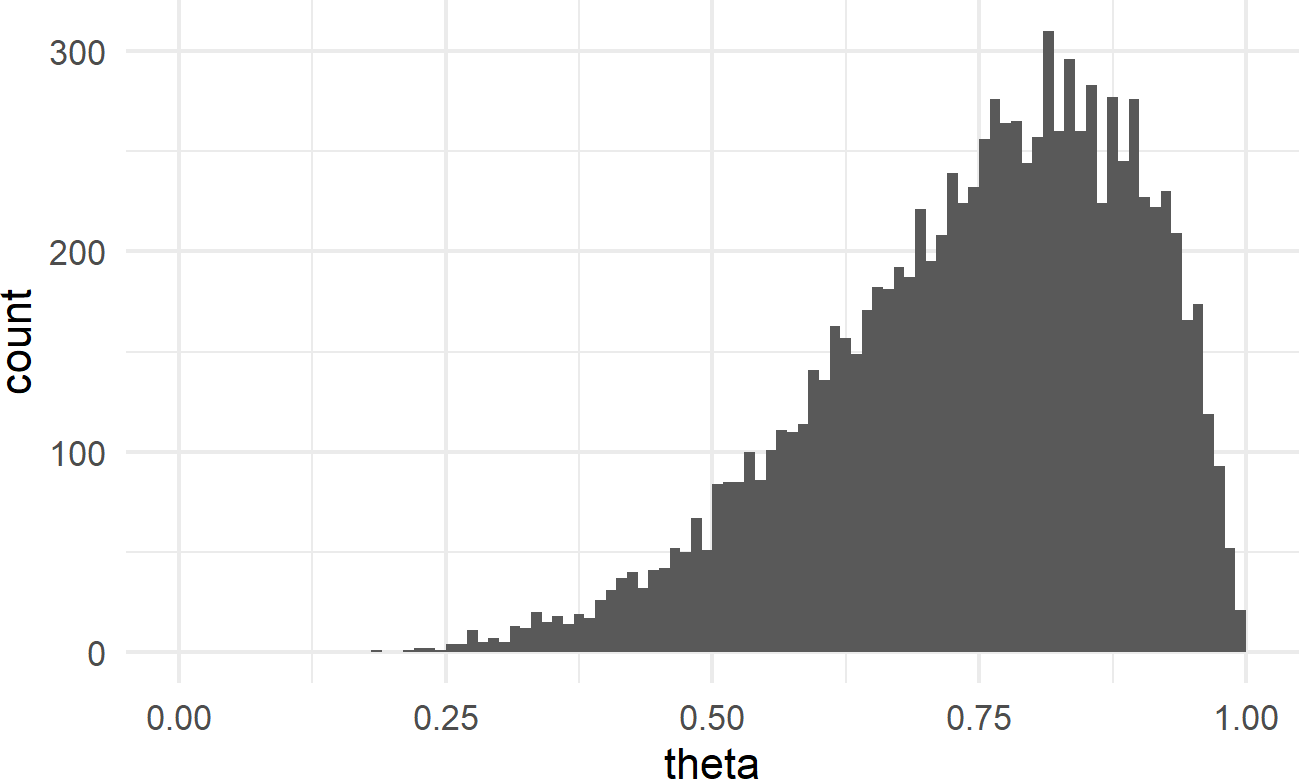
As a prior for a Bernoulli parameter, Figure 17.2 does seem valid in the sense that theta values in the representative sample than lower theta values). So, to use this prior suggests that you have a strong prior belief that
success is more likely than failure.
17.2 Matching beta Parameters to Your Beliefs
With named probability distributions, we can use the stat_function layer available with ggplot to plot the exact distribution instead of the approximated distribution using a representative sample. For example, Figure 17.3 was made using the below code to plot the exact
# create df with x-axis bounds
df = tibble(thetaBounds = c(0,1))
# initialize plot with bounds for x-axis
ggplot(df, aes(x=thetaBounds)) +
stat_function(fun=dbeta,
args = list(shape1 = 6, shape2 = 2))Figure 17.3: The exact probability density function for a random variable with a beta(6,2) distribution.
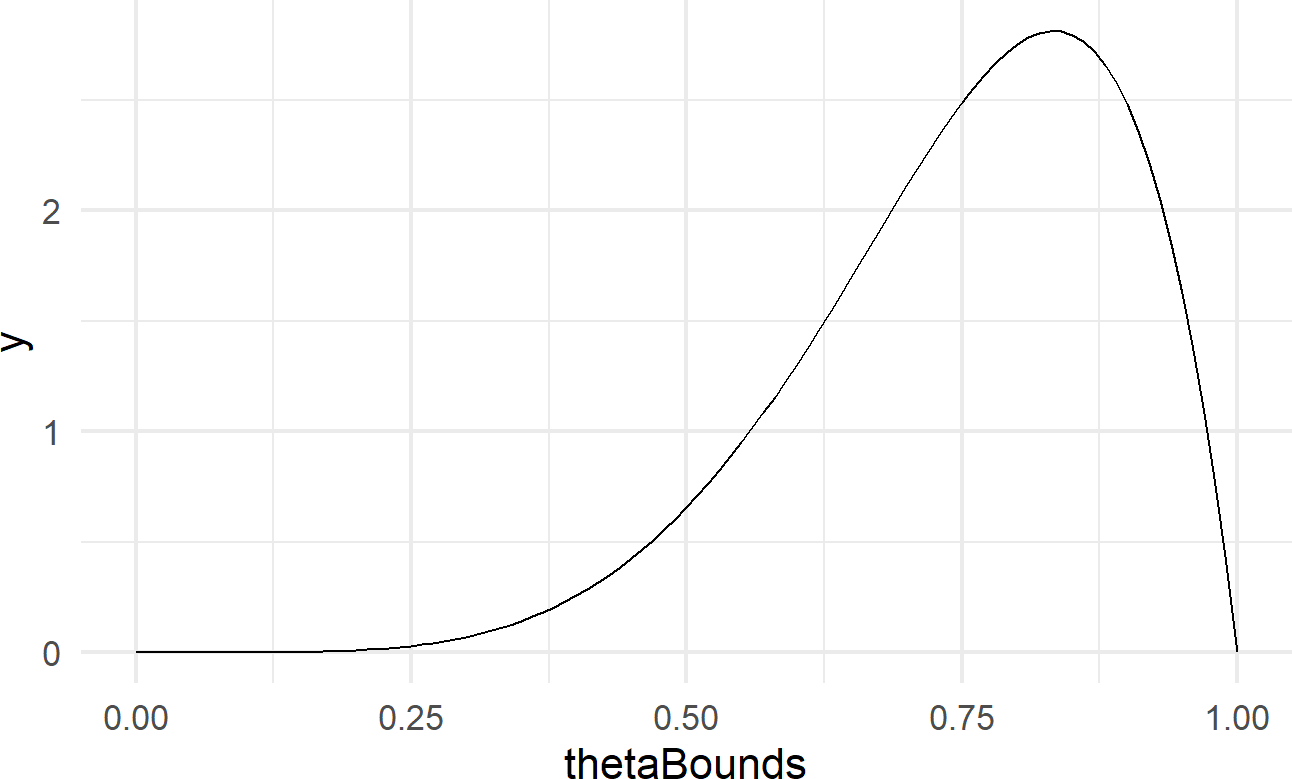
The function dbeta is an example of the
dfoo functions discussed in the Representing Uncertainty
chapter. For RV
For most functions, stat_function is useful to get a quick visual. However, I prefer to use geom_area for probability density functions because the area under the curve represents probability and filling this area in with a color reminds us of this (see Figure 17.4 for example).
ggplot(df, aes(x=thetaBounds)) +
geom_area(stat = "function",
fun=dbeta,
args = list(shape1 = 6, shape2 = 2),
fill = "cadetblue")Figure 17.4: Using geom area instead of stat function to plot a beta(6,2) distribution.
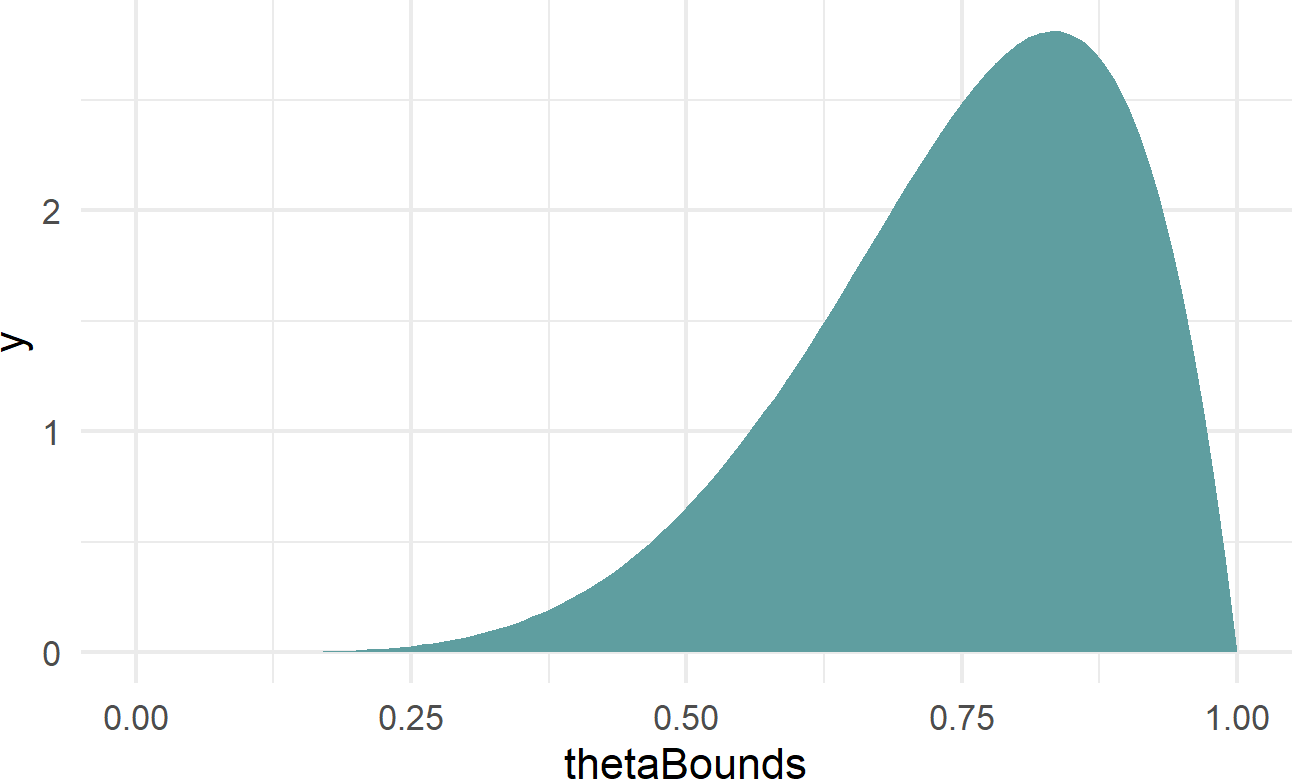
Figure 17.4 yields the same information as our representative sample shown in Figure 17.2; it just looks a little fancier. From the perspective of using the thetaBounds values below 0.5, so using this prior also suggests that the coin has the potential to be tails-biased; we would just need to flip the coin and see a bunch of tails to reallocate our plausibility beliefs to these lower values.
17.3 Investigating Various Parameters of The beta Distribution
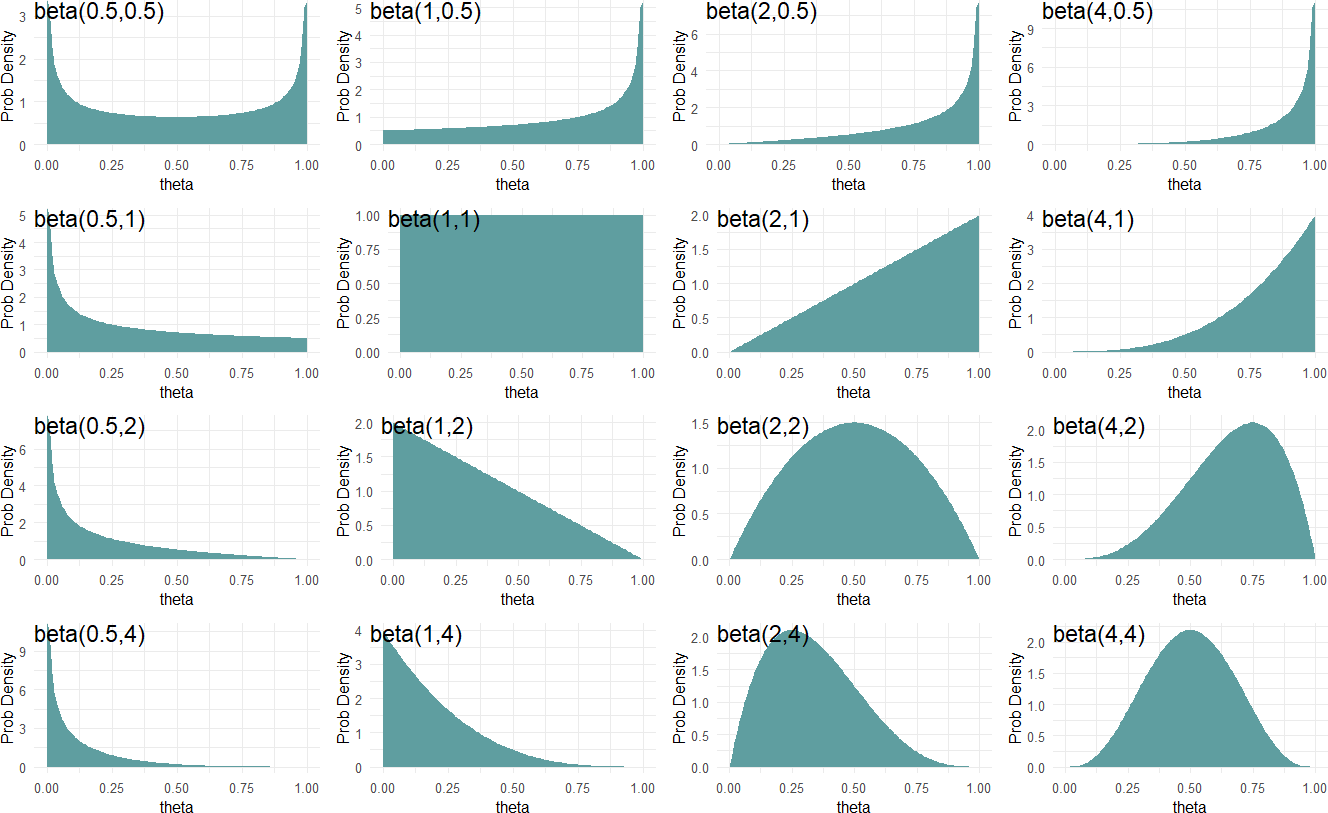
Figure 17.5: A diversity of beliefs about success probability can be modelled using different beta-distribution parameters.
Figure 17.5 shows beta distributions for various theta values closer to zero or one have higher density values than values closer to 0.5. At the other end, a
The
you can roughly interpret
and as previously observed data where the parameter is the number of successes you have observed and the parameter is the number of failures.
Hence, a
Figure 17.6: Comparing beta(1,1), beta(10,10), beta(10,20), and beta(500,500) distributions.
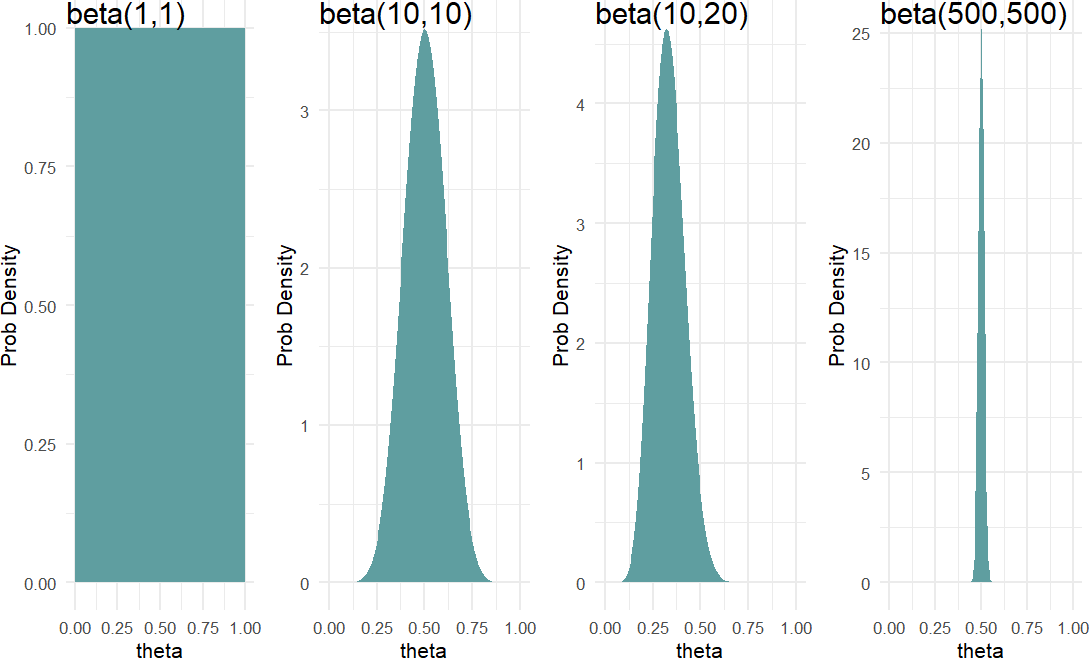
Moving forward, we will often use the
THOUGHT Question: Let theta represent the probability of heads on a coin flip. Which distribution, beta(0.5,0.5), beta(1,1), beta(2,2), beta(50,100) or beta(500,500) best represents your belief in theta given that the coin is randomly chosen from someone’s pocket?
THOUGHT Question: Which distribution, beta(0.5,0.5), beta(1,1), beta(2,2), beta(50,100), or beta(500,500) best represents your belief in theta given the coin is purchased from a magic store and you have strong reason to believe that both sides are heads or both sides are tails?
17.4 Using a beta Prior
Let’s now use generative DAGs with the
Figure 17.7: Graphical model for Bernoulli data with a beta prior.
Figure 17.7 is a generative DAG declaring a dag_numpyro() to get our posterior:
# assume twenty successes and two failures
successData = c(rep(1,20),rep(0,2))
# get representative sample of posterior
graph = dag_create() %>%
dag_node("Bernoulli RV","x",
rhs = bernoulli(theta),
data = successData) %>%
dag_node("Bernoulli Parameter RV","theta",
rhs = beta(2,2),
child = "x")
drawsDF = graph %>% dag_numpyro()And once the posterior sample (drawsDF) is created, we can query the results and compare them to the
library(tidyverse)
# named vector mapping colors to labels
colors = c("beta(2,2) Prior" = "aliceblue",
"Posterior" = "cadetblue")
# use geom_density to create smoothed histogram
ggplot(drawsDF, aes(x = theta)) +
geom_area(stat = "function", fun = dbeta,
args = list(2,2),
alpha = 0.5, color = "black",
aes(fill = "beta(2,2) Prior"))+
geom_density(aes(fill = "Posterior"),
alpha = 0.5) +
scale_fill_manual(values = colors) +
labs(y = "Probability Density",
fill = "Distribution Type") +
xlim(0,1)Figure 17.8: Posterior distribution is right-shifted from the beta(2,2) prior distribution after observing data with 20 successes and 2 failures.
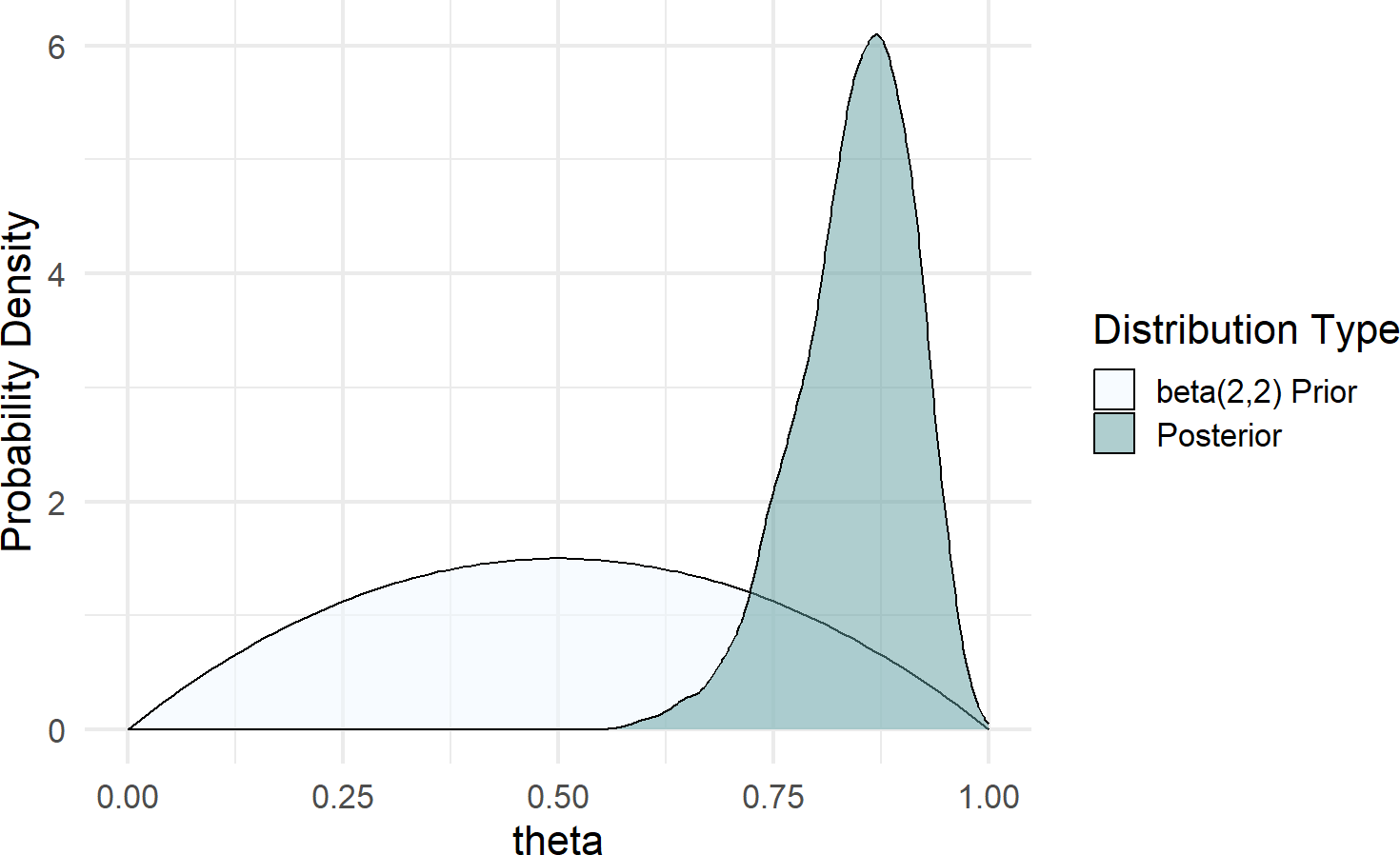
Figure 17.8 shows a dramatic shift from prior to posterior distribution. The weak prior suggested ot us that all values between zero and one had plausibility, but once observing 20 successes out of 22 trials, the higher values for
If we want to change the prior to something stronger, say a dag_numpyro() after just changing the one line for the prior:
graph = dag_create() %>%
dag_node("Bernoulli RV","x",
rhs = bernoulli(theta),
data = successData) %>%
dag_node("Bernoulli Parameter RV","theta",
rhs = beta(50,50), ### UPDATED FOR NEW PRIOR
child = "x")
drawsDF = graph %>% dag_numpyro()Figure 17.9: Posterior distribution is right-shifted from the beta(2,2) prior distribution after observing data with 20 successes and 2 failures.
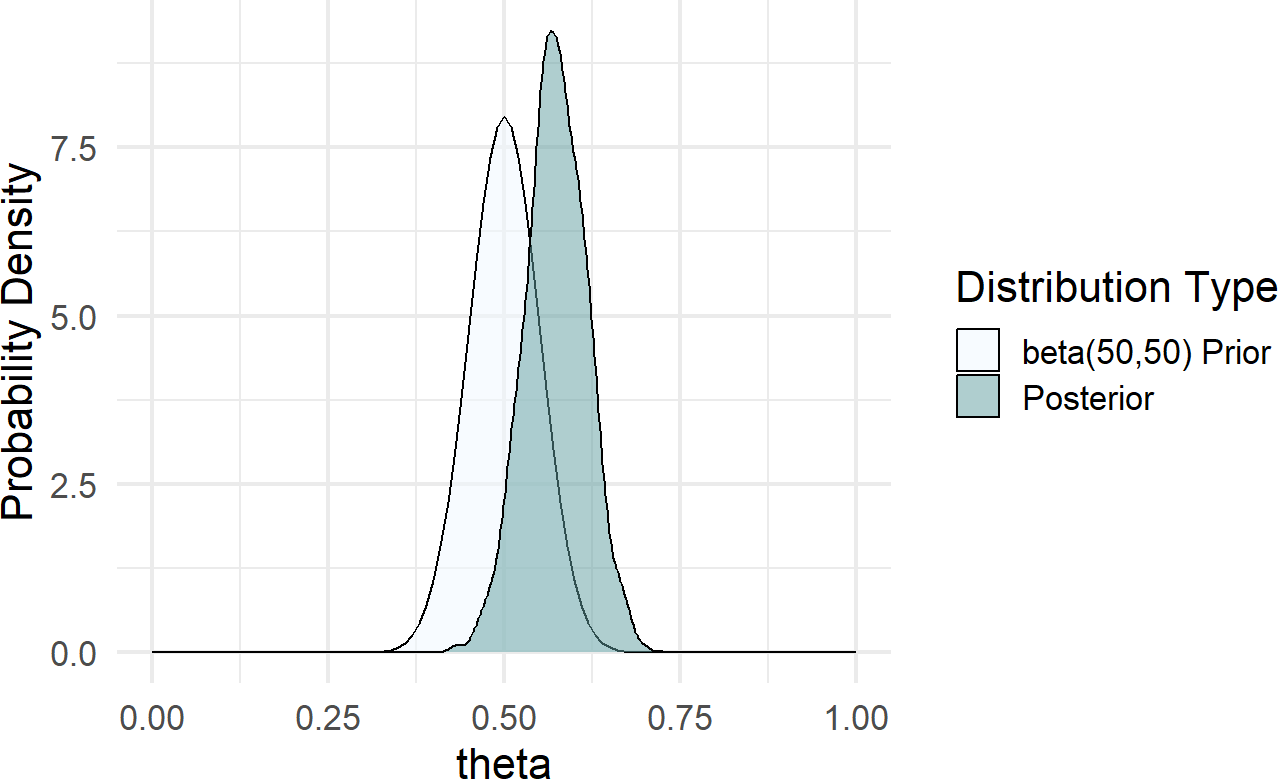
Figure 17.9 shows a posterior distribution that is only mildly shifted from its prior. This is a direct result of a strong prior due to the larger
17.5 Exercises
Figure 17.10 shows the generative DAG to be used in answering the following exercises:
Figure 17.10: A generative DAG for the results of a taste testing survey.
Your company has been testing two flavors of coffee using free samples, let’s call them Flavor A and Flavor B. You are planning to only offer one flavor for sale and are interested in whether your customers prefer Flavor A or Flavor B.
You use a taste testing survey of 60 randomly selected people, and find that 36 people prefer Flavor B.
Exercise 17.1 Using causact and assuming the generative DAG of Figure 17.10, determine the posterior probability that Flavor B is preferred to Flavor A. In other words, what percentage of your posterior draws have a theta that is above 0.5?
Exercise 17.2 You use a taste testing survey of 600 randomly selected people, and find that 360 people prefer Flavor B.
Using causact and assuming the generative DAG of Figure 17.10, determine the posterior probability that Flavor B is preferred to Flavor A. In other words, what percentage of your posterior draws have a theta that is above 0.5?